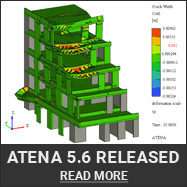ATENA version 5.4
ATENA version 5.4
brings many new and exciting features mainly to increase the support for modeling practical problems in bridge engineering or to improve the support for large scale models.
The main new features are:
- new finite elements for 2D shells and 1D beams
- diagrams for internal forces, moment, shear, normal and torsion are available also for solid continuum elements
- visualization diagram for 1D elements, for instance reinforcement stresses, bond stresses or bond slip
- user friendly, accurate and realistic modeling of pre-stressing losses
- loads can be applied at arbitrary locations
- user defined view can be created, stored and shared among various projects
- new tutorial problems and manuals for selected problem types:
- fiber reinforced concrete: FRC, EEC, SHCC, HPFRC, UHPFRC
- strengthening by carbon fiber rods, lamellas or sheets
- construction process modeling
The new version brings many new and exciting features based on the suggestion and feedback of our ATENA users.
|
Fig. 1: Design of TBM lining from FRC tubings for Ejpovice railway tunnel was supported by ATENA |
Fig. 2: Crack development in the analysis of FRC tunnel |
|
New finite elements: ATENA now supports also classical 1D beam and 2D shell elements (Fig 3 and 5). ATENA was always a specialized software for detailed reinforced concrete analysis. As such the emphasis was always on 2D/3D analysis using continuum based elements, which were enhanced by our specialized 3D beam and shell elements. ATENA users, however, want to apply nonlinear analysis to large scale structural problems, when classical beam and shell elements provide an efficient option. New features in ATENA Studio: |
Fig. 3: Example of thermal load on RC frame building |
|
Fig. 4: Top - evolution of prestressing with losses, Bott. |
Fig. 5: Building model using 2D shell and 1D beam elements showing the moment development in the columns |
|
Fig. 6: Concrete cracking above the main support,
|
New modelling of pre-stressing losses: The improved bond model enables very accurate and detailed modeling of pre-stressing losses due to friction and cohesion in tendon pipes as well as the subsequent tendon grouting with increased bond properties (see Fig. 4). Bond model can be activated in ATENA just by a single mouse click, no need for special interface elements or other complicated modeling tricks. Loads at arbitrary locations: Loads can be now applied at arbitrary locations, i.e. at point, lines or surfaces that do not need to be part of any geometric entity. This new feature greatly simplifies the application of complex loading patterns or moving loads. |
|
New tutorials: Several new tutorials have been developed and are available for download. They provide a step by step guidance in some of the typical ATENA application areas: |
Fig. 7: Process of FRC material model parameter |
|
Fig. 8: Failure of a model strengthened by FRP fabric |
Tutorial for ATENA Science GiD Construction Process - Construction process involves changing of structural geometry or properties during the construction. ATENA simulation system allows changes both in geometry, loads, boundary conditions as well as material properties at any time during the analysis. The first tutorial covers the application area of bridge construction. ATENA however supports also the modelling of tunnel construction process. This tutorial is currently under preparation and will be released before the end of the year. Please follow the download section on our website to learn about the new tutorials as they will be released. |
Maintenance and support
We strongly support our users in their analytic work with ATENA. Support is mainly provided by email and phone calls. The solution to many questions can be found also in our FAQ & Online Forum. New versions of ATENA are released every year.
Maintenance is provided for free for one year after the software purchase. After that is it can be prolonged at annual rate coresponding to 15% of the program price.
-
System requirements
- Minimum: PC with MS Windows XP SP2 / Windows Vista SP1, 512 MB RAM, 40 GB HDD, GPU with OpenGL 1.1 and 1024x768 resolution.
- Recommended: PC with MS Windows 7, 64 bit 8 GB RAM, 500 GB HDD, GPU with OpenGL and HW acceleration, designed for CAD (nVidia FX, AMD FireGL, etc.)












